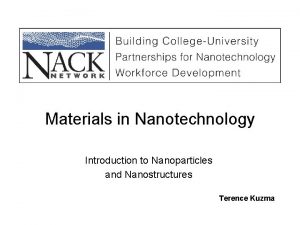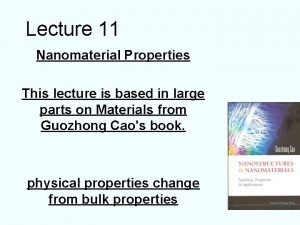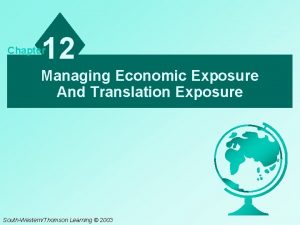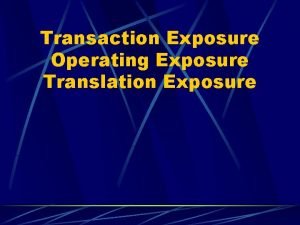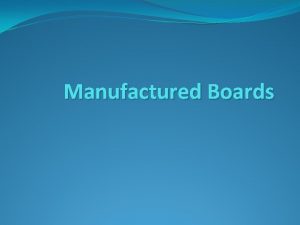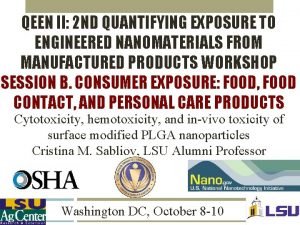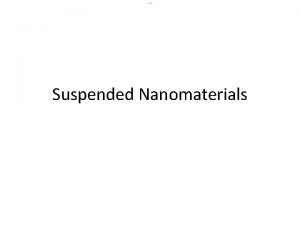QUANTIFYING EXPOSURE TO ENGINEERED NANOMATERIALS FROM MANUFACTURED PRODUCTS








- Slides: 8

QUANTIFYING EXPOSURE TO ENGINEERED NANOMATERIALS FROM MANUFACTURED PRODUCTS QEEN II WORKSHOP SUMMARY OCTOBER 11, 2018

RISK-BASED FRAMEWORK FOR ADDRESSING NANOTECHNOLOGY HEALTH AND SAFETY IMPLICATIONS • 2011 National Nanotechnology Initiative (NNI) Environmental, Health, and Safety (EHS) Research Strategy • Employ science-based risk analysis and risk management • Research Needs • Understand processes and factors that determine exposures to nanomaterials • Identify population groups exposure to engineered nanomaterials • Characterize individual exposures to nanomaterials • Conduct health surveillance of exposed

The 2011 NNI EHS Strategy: A conceptual framework that incorporates risk-assessment, risk management, and life cycle analysis to inform specific research principles Source: EPA 3

Call to Action for Exposure Science and Nanotechnology Communities Quantifying Exposures to Engineered Nanomaterials (QEEN) Workshop July 7 -8, 2015, Rosslyn, VA • Co-sponsored by CPSC and NNI • Bring together and engage stakeholders • Focus on lifecycle exposures: from production, use and disposal • Identify methods and approaches from various media • Understand global efforts for exposure science • Re-invigorate US – EU Communities of Research (COR) QEEN report released March 28, 2016 nano. gov

QEEN II HIGHLIGHTS • Informative sessions with experts in exposure assesment, metrology, toxicology, epidemiology and other disciplines • Dosimetry modeling and computational approaches to evidence integration • Exposure to nanomaterials in agroecosystems and agricultural production • Integrating exposure and toxicity assessments of nanomaterials at different states of the lifecycle • Emerging Technologies and Advanced Materials: Stakeholder Perspectives on Exposure, Hazard, and Risk Assessment • More time for discussion and interaction • New investigators and the “old guard”

WHAT HAVE WE LEARNED? • Exposure plays a critical role in understanding health risks • We have made significant progress in “Nano exposure science” • The tools are available to characterize and quantify exposures • • Availability and costs (e. g. , TEM)? We can reduce occupational exposures even when there are unknowns • PPE and engineering controls are effective for nanoparticles • Exposure assessment and toxicology • • Need toxicology data relevant for real world exposures Account for changes in nanoparticles across the lifecycle • • Morphology, coatings, functional groups, protein coronas Exposure does not equal dose • • Factors influencing uptake, transformations and disposition Increased interaction with toxicology, exposure, epidemiology and other communities

WHAT WERE THE KEY QUESTIONS Unique size and structure – will the effects be unique? – What is the appropriate metric for evaluating nanomaterials? – Will we need new assays to evaluate the toxicity? – Can we develop the appropriate tools to evaluate exposure? – Do we need to develop an entirely new risk assessment paradigm to evaluate nanomaterials? – Should we develop Nanoexposure science as a discipline as a complement to Nanotoxicology?

PATH FORWARD • COMMUNICATION • “We” don’t know it, or you don’t know it exists? ? ? • How to improve data sharing? • More effectively utilize meetings, workshops and webinars • Outreach to new investigators • Support standards and other global activities • OECD WPMN SG 8, ISO TC 229, ASTM E 56,
 Introduction about nanoparticles
Introduction about nanoparticles Mechanical properties of nano materials
Mechanical properties of nano materials Magnetic properties of nanomaterials
Magnetic properties of nanomaterials Unit 7 engineered wood products
Unit 7 engineered wood products Total wear solutions
Total wear solutions Economic exposure refers to
Economic exposure refers to Managing economic exposure and translation exposure
Managing economic exposure and translation exposure Managing economic exposure and translation exposure
Managing economic exposure and translation exposure Operating exposure adalah
Operating exposure adalah
